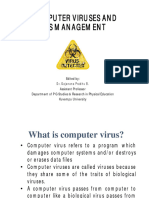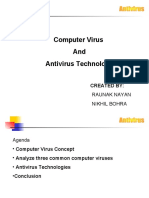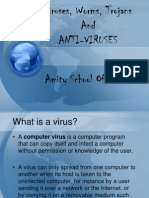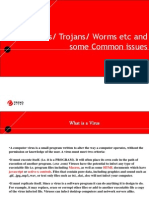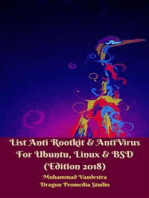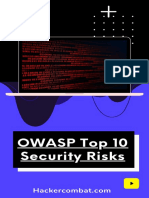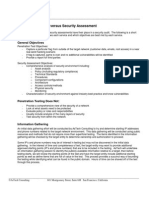Computer Viruses: Everything You Wanted To Know About
Computer Viruses: Everything You Wanted To Know About
Uploaded by
Santhosh KumarOriginal Description:
Original Title
Copyright
Available Formats
Share this document
Did you find this document useful?
Is this content inappropriate?
Report this DocumentCopyright:
Available Formats
Computer Viruses: Everything You Wanted To Know About
Computer Viruses: Everything You Wanted To Know About
Uploaded by
Santhosh KumarCopyright:
Available Formats
Everything you wanted to know about
Computer Viruses
What it all about
About virus.
History of virus.
Types of virus.
How virus spread.
How it work.
Protection from virus.
Free to ask any question at any point
What is a virus?
A virus is a computer program that
enter a computer without permission or
knowledge of the user and alter the way
a computer operates.
A virus is a software that
piggybacks on other programs and
change or delete the data, whenever
those programs are run.
Why virus are called virus
Computer viruses are called viruses because they
share some of the traits of biological viruses.
A computer virus passes from computer to
computer like a biological virus passes from person
to person.
Computer virus can self replicate themselves like
biological virus.
As biological virus, computer virus also effect the
program or machinery in they exist.
History of virus
Len Adelman coins the term virus in 1983.
First virus Elk Cloner created by Rich
Skrenta, in 1982 it attack Apple DOS 3.3
operating system and spread by floppy
disk.
In 1983, Fred Cohen writes a paper
Computer viruses Theory and
Experiments
History of virus (continue)
In 1986, two brothers Basit and Amjad Farooq Alvi
created a boot sector virus called cBrain.
Internet worms, in 1988 causes first Internet
crises and shuts down many computers.
Again in 1988, Jerusalem virus that activates on
every 13
th
Friday affects both .exe and .com files
and delete any program that run on that day.
In 2000, Denial of Service attack shuts down
yahoo, Amazon and other web sites.
History of virus (continue)
Love letter worm shuts down e-mail system in
2000.
MY DOOM the largest virus attack till date
which effected one million computer world wide,
was detected first on 26 January 2004.
It affect one in every 10 e-mail message.
Slow down internet performance by 10% and
download time by 50%.
Types of virus
File infector viruses
Boot sector viruses
Multi-partite viruses
Macro viruses
Script viruses
Companion viruses
File Infector Viruses
Attaches itself to other program files.
When these programs are run from
floppy, hard drive, or network they effect
to other file.
Many are memory resident.
When any file that is executed in that
memory also becomes infected.
Examples: Jerusalem and cascade
Boot Sector Viruses
Effect the system boot sector of a disk.
(boot record on floppy/hard disks)
Activate when user starts up from infected
disk.
Always memory resident in nature.
Once in memory, all non-write protected
floppy disks will become infected when
accessed.
Examples: Form, Disk Killer and Stoned
Multi-Partite Viruses
Effect both boot records and program files.
Difficult to repair.
Boot area and files must both be cleaned from
virus otherwise re-infection will occur.
Examples: One_Half, Emperor, Anthrax .
Macro Viruses
Most common type of virus.
They are hard to detect.
Effect program that contain macro
programming language.
Infect data files word, excel, power point
and access files.
As these files are share more frequently
they cause more damage.
Embedded with document.
Therefore when edit from one file do not
reflected in other files.
Script Viruses
Effect various script languages such as DOS, Java
Script, and Visual Basic Script.
Companion Viruses
Execute through operating system rather than
directly infecting programs or boot sectors.
When you execute the command ABC, ABC.COM
executes before ABC.EXE. Thus, a companion virus
could place its code in a .COM file with its first name
matching that of an existing EXE file. When the user
next executed the ABC command, the virus
ABC.COM program would be run.
Other Threats to Computers
Worm
Torjan horse
Trap doors
Bacteria
Worms
Worms replicate themselves.
Instead of spreading from file to file they
spread from computer to computer,
infecting an entire system.
They steal user name and password and try
to log in to other machine.
Torjan horse
They look as a useful
program but cause
damage or do
something malicious
to a system.
Dont makes copies of
themselves.
Trap Doors
It is secret point in a program that by passes
standard authentication.
Attackers leave behind trap doors to reenter
the system easily.
Bacteria
They do not cause any destruction.
They replicate themselves and thus consume
system space.
How viruses spread
By downloading infected files or programs from a
network, there is a chance that you can encounter
a computer virus.
Once you RUN an infected program, the virus can
spread rapidly, especially on networks. That is
why the Internet, the largest network, is a fertile
breeding ground for viruses.
By inserting infected disks into your computer.
How viruses spread (continue)
How viruses spread (continued)
Computers do get viruses from e-mail via
internet.
The virus will come in the form of some kind of
attachment. Opening the attachment can give
your computer a virus.
Use of floppy disk, pen drives ,etc.
Effect of virus
Display a message
Effect of virus (continue)
Erase vital data.
Scramble data on a hard disk
Cause erratic screen behavior
Halt the PC
Many viruses do nothing obvious at all except
spread!
Damage hardware
Effect of virus (continue)
A denial-of-service attack is an attack that causes a
loss of service to users such as loss of network
connectivity.
By consuming the bandwidth of the victim network.
How viruses works?
Different virses uses different methods to
operate.
Like denial-of-service flood the incoming
messages to the target system and thus
consumes all bandwidth so forces it to shut
down.
Working of File virus
There are three basic techniques for infecting an
executable file:
Overwrite - An overwriting virus places itself at
the beginning of the program, directly over the
original program code.
When you try to run this program, nothing
happens except for the virus infecting another
files.
Working of File virus (continue)
Prepend this virus put its code onto the
file and when it is executed, virus code is first
run then file gets executed.
Working of file virus (continue)
Append -An appending virus places a jump
instruction at the beginning of the program
file, which moves the original beginning of the
file to the end of the file, and places itself at
that point, When you try to run this program,
the jump calls the virus, and the virus runs.
Boot sector virus
If CMOS is set up to boot from drive A: or from CD-
ROM then the system boot sector (SBS) of the disk
will be read.
If the SBS contains a boot virus, the boot virus will
become active, go inside memory
It effect the system areas of the hard drive, and other
disks that will access later on.
Protection from virus
Install an anti-virus program.
Regularly update your anti-virus.
Examples -
Norton Antivirus
McAfee virus scan
Protection from virus (continue)
Dont open unknown files.
Dont use or share floppies, CD or pen drive
without scanning with anti-virus.
If you dont know who the message is from,
dont open it.
If you receive a suspicious message, delete it.
Never double-click to open an attachment that
contains an executable that arrives as an e-mail
attachment.
Protection from virus (continue)
Do not install pirated software, especially
computer games.
Regularly scan entire hard disk.
HAVE A NICE TIME
You might also like
- Running Odoo in HTTPS Using Nginx - by Latnok CDDocument4 pagesRunning Odoo in HTTPS Using Nginx - by Latnok CDCoko Mirindi MusazaNo ratings yet
- Cse Instructor Materials Chapter1Document38 pagesCse Instructor Materials Chapter1api-224615605No ratings yet
- Gurjinder Singh RG1001A26 11007251Document23 pagesGurjinder Singh RG1001A26 11007251varpaliaNo ratings yet
- By Rashmi Ravi: Roll No.66 S.Y.Bcom B'Document16 pagesBy Rashmi Ravi: Roll No.66 S.Y.Bcom B'Rashmi RaviNo ratings yet
- Malicious SoftwareDocument38 pagesMalicious SoftwareAkshay KothariNo ratings yet
- 7#lect 7 ComputerVirusDocument30 pages7#lect 7 ComputerVirussaadkan000No ratings yet
- Virus and Antivirus: Team Members: - Muzaffar Malik - Kiran KarkiDocument17 pagesVirus and Antivirus: Team Members: - Muzaffar Malik - Kiran Karkikumarishu125No ratings yet
- Threats Are Divided in Major Two Categories: Internet SecurityDocument98 pagesThreats Are Divided in Major Two Categories: Internet SecurityAman RoyNo ratings yet
- Computer VirusDocument25 pagesComputer VirusShubham Trivedi100% (1)
- The Things You MUST Know: Brought To You by Sumanta Majumdar Dept. of Electrical Engg. 2010, GNITDocument16 pagesThe Things You MUST Know: Brought To You by Sumanta Majumdar Dept. of Electrical Engg. 2010, GNITLakshmi NarasimhanNo ratings yet
- Virus and Its ManagementDocument25 pagesVirus and Its Managementpradhanniranjan345No ratings yet
- Computer Virus and Antivirus Technology: Created By: Raunak Nayan Nikhil BohraDocument38 pagesComputer Virus and Antivirus Technology: Created By: Raunak Nayan Nikhil BohraShruti GuptaNo ratings yet
- Computer Viruses and Its Management: Edited byDocument9 pagesComputer Viruses and Its Management: Edited byWilliam KaamuNo ratings yet
- Viruses Worms and Other MalawareDocument49 pagesViruses Worms and Other MalawareMayank SinghNo ratings yet
- VirusDocument23 pagesVirusapi-26349602No ratings yet
- What Is A Computer Virus?Document9 pagesWhat Is A Computer Virus?Mayur MehtaNo ratings yet
- BAL GL: Institute of Information TechnologyDocument24 pagesBAL GL: Institute of Information TechnologyJegr AbasNo ratings yet
- Computer InfestationDocument5 pagesComputer InfestationmwaniaabediNo ratings yet
- Antivirus Program & Its Usage: Presented By: Ankit Khurana HCE-40Document40 pagesAntivirus Program & Its Usage: Presented By: Ankit Khurana HCE-40RavithegeniousNo ratings yet
- Computer Program Malware Adware SpywareDocument18 pagesComputer Program Malware Adware SpywareAnand GuptaNo ratings yet
- How Computer Viruses WorkDocument16 pagesHow Computer Viruses WorkNitin MathurNo ratings yet
- Viruses, Worms, Trojans and Anti-Viruses: Arun Kumar Roll No. 35 Section-150Document18 pagesViruses, Worms, Trojans and Anti-Viruses: Arun Kumar Roll No. 35 Section-150Mustafa AliNo ratings yet
- Computer MalwareDocument11 pagesComputer MalwareparimalaNo ratings yet
- Viruses, Worms, Trojans and Anti-Viruses Amity School of BusinessDocument21 pagesViruses, Worms, Trojans and Anti-Viruses Amity School of BusinessSanchit GuptaNo ratings yet
- Computer VirusDocument24 pagesComputer VirusAvneet KaurNo ratings yet
- Cce-Edusat Session For Computer FundamentalsDocument37 pagesCce-Edusat Session For Computer FundamentalsGemark AlmacenNo ratings yet
- IT Presentation 1 (Group 4)Document37 pagesIT Presentation 1 (Group 4)Amina FarooqNo ratings yet
- Introduction (Viruses, Bombs, Worms) - Types of Viruses - Characteristics of Viruses - Categories of Viruses - Computer SecurityDocument36 pagesIntroduction (Viruses, Bombs, Worms) - Types of Viruses - Characteristics of Viruses - Categories of Viruses - Computer SecurityMd Sajjad HossainNo ratings yet
- Virus Antivirus: (N.R.Thombare) (Nrthombare@bsnl - Co.in)Document45 pagesVirus Antivirus: (N.R.Thombare) (Nrthombare@bsnl - Co.in)nrthombareNo ratings yet
- Malware Lecture 7Document46 pagesMalware Lecture 7sadiasm125No ratings yet
- Computer Virus and Antivirus 1211556532039865 9Document22 pagesComputer Virus and Antivirus 1211556532039865 9Abdulai SheriffNo ratings yet
- Virus and AntivirusDocument18 pagesVirus and AntivirusJacob CharlesNo ratings yet
- Apply Computer and Mobile TechnologyDocument9 pagesApply Computer and Mobile Technologyabdiaboma65No ratings yet
- Computer Memory Networks Security Arpanet Antivirus Programs Programs Computer SystemDocument6 pagesComputer Memory Networks Security Arpanet Antivirus Programs Programs Computer SystemShobaNa ShaNatriNo ratings yet
- Viruses & Worms: CS431 Dick SteflikDocument21 pagesViruses & Worms: CS431 Dick SteflikJanardan PrasadNo ratings yet
- VirusDocument8 pagesVirusRavula KartheekNo ratings yet
- PC Viruses: How They Got The Name What They Are How They Spread How To Prevent ThemDocument25 pagesPC Viruses: How They Got The Name What They Are How They Spread How To Prevent ThemRandy Alejaga RosalesNo ratings yet
- PIP Computer VirusesDocument12 pagesPIP Computer VirusesAcousticParesh PatelNo ratings yet
- FIS Chapter 5Document14 pagesFIS Chapter 5samuel mulatuNo ratings yet
- COMPUTER VIRUS AND TYPES AssignmentDocument6 pagesCOMPUTER VIRUS AND TYPES AssignmentNafisa IjazNo ratings yet
- To The World of KnowledgeDocument25 pagesTo The World of KnowledgelavikaNo ratings yet
- Computer VirusDocument18 pagesComputer VirusDevesh DewanganNo ratings yet
- Hi!! I Am A VIRUS!!Document46 pagesHi!! I Am A VIRUS!!aafy100% (1)
- Virus PPT Wid Different ThemeDocument18 pagesVirus PPT Wid Different ThemeRaji KaurNo ratings yet
- PesentationDocument11 pagesPesentationAhsan frazNo ratings yet
- VirusDocument20 pagesVirusamuljuneNo ratings yet
- Networking Training: CybersecurityDocument26 pagesNetworking Training: CybersecurityAnonymous DIFDo05GfSNo ratings yet
- Anti VirusDocument41 pagesAnti VirusbondbabaNo ratings yet
- Virus/ Trojans/ Worms Etc and Some Common Issues: RUNNING HEADER, 14 PT., ALL CAPS, Line Spacing 1 LineDocument8 pagesVirus/ Trojans/ Worms Etc and Some Common Issues: RUNNING HEADER, 14 PT., ALL CAPS, Line Spacing 1 LinereneeshczNo ratings yet
- ICT Viruses 2Document10 pagesICT Viruses 2Ahmad TVNo ratings yet
- PC Viruses: How They Got The Name What They Are How They Spread How To Prevent ThemDocument54 pagesPC Viruses: How They Got The Name What They Are How They Spread How To Prevent ThemTechBeats IndiaNo ratings yet
- What Is A Virus'?: Manual For Computer Application-I By:er. A YadavDocument4 pagesWhat Is A Virus'?: Manual For Computer Application-I By:er. A YadavRaju KumaarNo ratings yet
- Lesson 6: Computer VirusDocument14 pagesLesson 6: Computer VirusKevin RainsNo ratings yet
- Computer Security ThreatsDocument56 pagesComputer Security ThreatsGetaneh MeleseNo ratings yet
- Computer Virus: - Abinaya M - Aarish Ramesh - AdithyaDocument37 pagesComputer Virus: - Abinaya M - Aarish Ramesh - Adithyaaarish-ramesh-5468No ratings yet
- Legal-Ethics-Lecture 3Document40 pagesLegal-Ethics-Lecture 3Dustin OdoiNo ratings yet
- Cs 14Document5 pagesCs 14Danish ShaikhNo ratings yet
- Introduction To Computer: Semester: BS 5 Environmental SciencesDocument22 pagesIntroduction To Computer: Semester: BS 5 Environmental Sciencesrida faizNo ratings yet
- Welcome To Our Welcome To Our: Presentatio NDocument33 pagesWelcome To Our Welcome To Our: Presentatio Ndurgesh30No ratings yet
- List Anti Rootkit & AntiVirus For Ubuntu, Linux & BSD (Edition 2018)From EverandList Anti Rootkit & AntiVirus For Ubuntu, Linux & BSD (Edition 2018)No ratings yet
- PKI OverviewDocument3 pagesPKI OverviewfilateiNo ratings yet
- OVERVIEW OF INFORMATION TECHNOLOGY ACT 2000 - Huzaifa SalimDocument9 pagesOVERVIEW OF INFORMATION TECHNOLOGY ACT 2000 - Huzaifa SalimHuzaifa SalimNo ratings yet
- Maharishi Arvind College of Engineering & Research Centre, JaipurDocument29 pagesMaharishi Arvind College of Engineering & Research Centre, JaipurNikhil Bhuta DhariyawadNo ratings yet
- Nana D 5 DR CVDocument2 pagesNana D 5 DR CVChakri ChaturvedNo ratings yet
- Tabnabbing Attack Method Penetration Testing LabDocument6 pagesTabnabbing Attack Method Penetration Testing LabEugenia CascoNo ratings yet
- Lesson 2: Rules of NatiquetteDocument20 pagesLesson 2: Rules of NatiquetteGabriel Cortez MercadoNo ratings yet
- Unit - 2: Onventional Ncryption PrinciplesDocument35 pagesUnit - 2: Onventional Ncryption PrincipleshafeezaNo ratings yet
- Kerlerec's CipherDocument17 pagesKerlerec's CipherDonald E. PuschNo ratings yet
- Enumeration & Exploitation & HardeningDocument1 pageEnumeration & Exploitation & Hardeningeloyx3xNo ratings yet
- C@shnet Password Maintenance Request FormDocument1 pageC@shnet Password Maintenance Request FormVic Bayonon100% (1)
- The Significance of Cybersecurity System in Helping Managing Risk in Banking SectorDocument15 pagesThe Significance of Cybersecurity System in Helping Managing Risk in Banking Sector01012682327021No ratings yet
- Security Issues in M-Commerce For Online Transaction: Deepak Kumar, Nivesh GoyalDocument6 pagesSecurity Issues in M-Commerce For Online Transaction: Deepak Kumar, Nivesh GoyalFaizan AliNo ratings yet
- Darwinbox Data Protection and PrivacyDocument11 pagesDarwinbox Data Protection and Privacysarveshbhor267No ratings yet
- Understanding and Responding To Ddos Attacks - 508cDocument9 pagesUnderstanding and Responding To Ddos Attacks - 508cJulio JordanNo ratings yet
- OWASP Top 10 Security RiskDocument9 pagesOWASP Top 10 Security RiskJorge CañaveralNo ratings yet
- Phishing Technique in E-Mail: Presented byDocument6 pagesPhishing Technique in E-Mail: Presented bykagal47No ratings yet
- ERS ConsultancyDocument6 pagesERS ConsultancyERS ConsultancyNo ratings yet
- SSL V/S Set: By-Neelu DeviDocument12 pagesSSL V/S Set: By-Neelu DeviKhushi GuptaNo ratings yet
- Security Assessment Vs Penetration TestingDocument3 pagesSecurity Assessment Vs Penetration Testinganil100% (1)
- Vulnerability/Threats On SDN Security Attacks On SDN Security SolutionsDocument12 pagesVulnerability/Threats On SDN Security Attacks On SDN Security SolutionsYo Its meNo ratings yet
- Cryptography Programming Workshop, Project 1: Submission InstructionsDocument7 pagesCryptography Programming Workshop, Project 1: Submission Instructionsחיים שפיראNo ratings yet
- How To Set Up Free SSL Certificates From Let's Encrypt Using Docker and Nginx PDFDocument38 pagesHow To Set Up Free SSL Certificates From Let's Encrypt Using Docker and Nginx PDFJosé Arturo García100% (1)
- NSA: Security Highlights of Windows 7Document2 pagesNSA: Security Highlights of Windows 7Brad BeckettNo ratings yet
- Fortimail Email Filtering Course 221 (For Fortimail V4.2)Document7 pagesFortimail Email Filtering Course 221 (For Fortimail V4.2)Pyae Sone TunNo ratings yet
- GitHub Fabacab Awesome Cybersecurity Blueteam ? A Curated CollectionDocument19 pagesGitHub Fabacab Awesome Cybersecurity Blueteam ? A Curated CollectionMarioGantengNo ratings yet
- New DMVDocument3 pagesNew DMVshazedislamNo ratings yet
- Lessons From The Lab: An Expert Guide To Trickbot, Darkside & Other Malware of 2021Document22 pagesLessons From The Lab: An Expert Guide To Trickbot, Darkside & Other Malware of 2021Yose MartinNo ratings yet
- COD 103 Creating Software Security RequirementsDocument20 pagesCOD 103 Creating Software Security RequirementsHariprasad ManchiNo ratings yet










